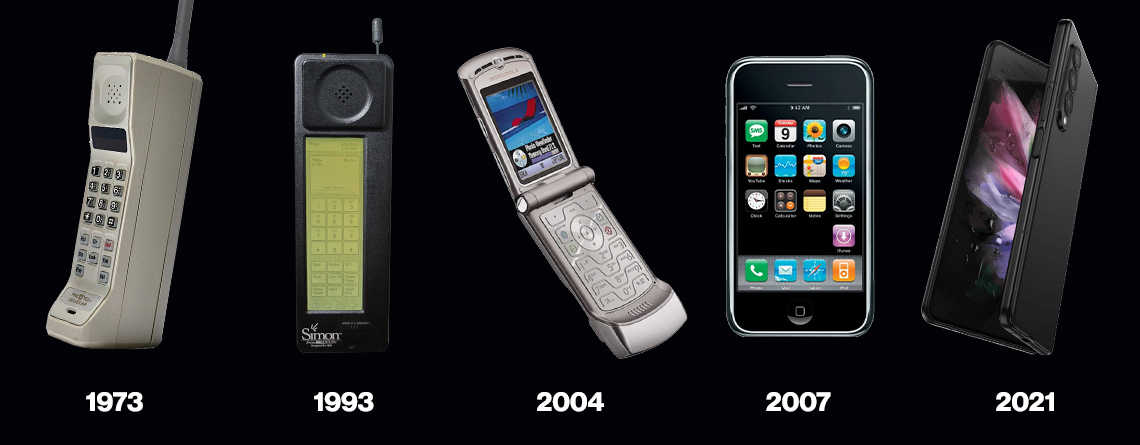Imagine holding the world in the palm of your hand. That’s the magic of the smartphone you use every day.
But have you ever wondered where it all began? The story of the first smartphone is not just about technology; it’s about a revolution that changed the way you live, communicate, and work. This tiny device has become your lifeline, your connection to everything and everyone you care about.
As you read on, you’ll uncover the fascinating history of how the first smartphone came to be and the visionary minds behind it. This isn’t just a tale of innovation; it’s a journey into understanding how one incredible idea reshaped your reality. Get ready to dive into a captivating story that reveals how the smartphone evolved from a simple concept to an essential part of your everyday life. Stay with us, because this is a story worth telling.

Credit: www.cellularsales.com
Origins Of Mobile Technology
The journey of mobile technology is a fascinating tale of human innovation and determination. Before we could stream videos or send emojis, the origins of mobile technology were humble yet groundbreaking. Understanding where it all began can give you a deeper appreciation for the smartphone in your pocket today.
The First Mobile Call: A Leap Towards Connectivity
Imagine being on the streets of New York in April 1973. Martin Cooper, a Motorola engineer, makes the first-ever mobile phone call. This call was not just a technological feat but also a significant step towards global connectivity.
Cooper’s call was made on a bulky device, resembling a brick more than a phone. It was a far cry from the sleek designs we see now. Yet, it laid the foundation for the interconnected world we live in.
The Evolution Of Mobile Devices: From Brick To Pocket
The first mobile phone was not user-friendly. It weighed over 2 pounds and had a battery life of just 30 minutes. But it was the beginning of a revolution.
As technology advanced, phones became smaller and more efficient. With each innovation, the dream of making communication accessible to everyone became more of a reality.
The Birth Of The Smartphone: A New Era
In 1992, IBM introduced the Simon Personal Communicator, often credited as the first smartphone. It combined the functionality of a mobile phone with a PDA (Personal Digital Assistant).
This device could send emails, manage contacts, and even had a touchscreen. It was a glimpse into the future, hinting at the possibilities of what smartphones could achieve.
Reflecting On Progress: How Far Have We Come?
Think about how you use your smartphone today. From navigating cities to video calls, the capabilities seem endless. Yet, it all started with a single call on a bulky device.
Understanding the origins of mobile technology can make you appreciate its evolution. What do you think the future holds for mobile technology? Will we see innovations that surprise us as much as that first call did?
Evolution Of Handheld Devices
The journey from bulky gadgets to sleek smartphones is fascinating. Handheld devices have transformed drastically over the years. The evolution showcases innovation and technological advancements. Understanding this history offers insights into modern conveniences.
Early Beginnings: The First Mobile Phones
The first mobile phones were large and cumbersome. They were mainly used by businesses. These devices were expensive and had limited functionality. Making calls was their primary purpose. Early models had long antennas and heavy batteries. Yet, they marked the beginning of wireless communication.
Advancements In Technology: Shrinking Sizes
Technological progress led to smaller, more portable phones. Batteries became compact, and antennas integrated. Manufacturers started focusing on user-friendly designs. These changes made mobile phones more accessible. People could carry phones in pockets and bags easily.
Introducing Smart Features: Rise Of Smartphones
Smartphones introduced more than calling capabilities. Internet access became a key feature. Users could browse, email, and download apps. This expanded the functionality of handheld devices. The concept of a “personal assistant” emerged. Phones started offering calendars and reminders.
Touchscreen Revolution: A New Era
Touchscreens changed the way users interacted with devices. Physical buttons were replaced by touch-sensitive screens. Navigation became intuitive and simple. This shift enhanced user experience greatly. The era of swiping and tapping began.
Constant Connectivity: Global Impact
Smartphones ensure constant connectivity with the world. Social media and messaging apps keep users engaged. Information is available at fingertips, anytime, anywhere. This connectivity influences social and cultural dynamics. Smartphones are integral to modern life.
Birth Of The Smartphone
In 1992, IBM introduced the world to the first smartphone, Simon Personal Communicator. This device combined features like calling, emailing, and a touchscreen, setting the stage for future innovations. Simon marked a significant shift in how people interacted with technology, bridging communication and computing.
The birth of the smartphone marked a pivotal moment in the history of technology. Imagine a world where accessing information meant sitting at a computer or flipping through pages. Then, suddenly, you could fit that entire world in your pocket. This transformation didn’t happen overnight. It was the result of years of innovation and the vision to create a device that seamlessly blends communication and computing.The Dawn Of A New Era
In the early 1990s, the world was introduced to a device that changed everything. The IBM Simon Personal Communicator, released in 1994, is often credited as the first smartphone. It was bulky by today’s standards but groundbreaking at the time. This device combined a mobile phone with a PDA (Personal Digital Assistant). You could make calls, send emails, and even use a calendar. Suddenly, you had more power in your hand than you ever did with a simple phone.Combining Communication And Computing
The Simon set the stage for what smartphones could be. It wasn’t just about making calls anymore; it was about integrating multiple functions into one device. This concept changed how we viewed mobile technology. Fast forward a few years, and other companies began to build on this idea. Each new model added more features, like the ability to browse the internet or download apps.Challenges And Innovations
Creating a smartphone wasn’t without its challenges. Engineers had to overcome issues like battery life, screen size, and user interface. But these challenges sparked innovation. Solutions like touchscreens and compact batteries emerged from this period. Think about the first time you used a touchscreen. It felt like magic, right? That magic was the result of solving real technical problems.Impact On Daily Life
The smartphone fundamentally changed how we live. Remember your first smartphone? It probably seemed like a luxury, but quickly became a necessity. Today, smartphones are central to how we communicate, work, and play. They have redefined convenience. Need to check the weather, book a flight, or navigate a new city? It’s all there, in the palm of your hand.Looking To The Future
The birth of the smartphone was just the beginning. As technology continues to advance, one can’t help but wonder what’s next. Will our phones become even more integrated into daily life? Could they eventually replace laptops or even more traditional forms of communication? As you use your smartphone today, consider how far we’ve come since that first bulky device. And think about where it might take us next.-min.jpeg)
Credit: www.textedly.com
Features Of The First Smartphone
The features of the first smartphone were groundbreaking at the time, laying the foundation for the powerful devices we now rely on daily. It was a world where technology was more of a luxury than a necessity, yet this device hinted at the limitless possibilities ahead. What were the features that made it so revolutionary?
Touchscreen Innovation
The first smartphone introduced the concept of a touchscreen. Imagine a device where you could interact directly with the screen instead of relying on physical buttons. It seemed futuristic and a bit magical. This innovation allowed users to navigate with a simple touch, changing the way we thought about phones. Have you ever wondered how different your life would be without a touchscreen? Would you feel more disconnected from your device?
Integrated Applications
Smartphones today come with apps for everything, but the first smartphone was the pioneer in integrating applications. It combined email, calendar, and contact features into one device. Suddenly, you could manage your work and personal life in the palm of your hand. It was like carrying a mini-office everywhere. How often do you check your email or calendar on your phone today? Could you imagine managing your day without these tools?
Connectivity Advancements
The first smartphone also advanced connectivity. It offered wireless communication, making it easier to stay in touch with the world. It was more than just making calls; it was about staying connected in new ways. You could access the internet, albeit slowly, and communicate through emails. Picture a time when sending an email from your phone was a novelty. How has the ability to connect anytime, anywhere, changed your communication habits?
The features of the first smartphone were indeed a glimpse into the future, shaping how we interact with technology today. Reflect on how these innovations have impacted your life. Would your daily routine be the same without the advancements that started with this pioneering device?
Impact On Communication
The first smartphone changed how people connect and share information. It brought email, calls, and messages into one device. This innovation made communication faster and more accessible, fitting everything into our pockets.
The introduction of the first smartphone transformed how we communicate in ways we never imagined. Suddenly, our ability to reach out to anyone, anywhere, was literally at our fingertips. This technological leap shifted the dynamics of communication, making interactions faster, more efficient, and remarkably convenient.The End Of Waiting
Before smartphones, waiting for responses was the norm. You’d send a letter or leave a voicemail and hope for a timely reply. With smartphones, instant messaging became the standard. Whether you’re texting a friend or emailing a colleague, you can expect a quick response, often within minutes. How has this immediacy changed your patience levels or expectations in communication?Always Connected
Smartphones ensure you’re never really offline. This constant connection can be both a blessing and a curse. On the upside, you can easily keep in touch with loved ones regardless of distance. But it also means there’s a pressure to be continuously available. Have you ever felt the need to disconnect, even just for a short while?Multifaceted Communication
Gone are the days when voice calls were the primary method of communication. With smartphones, you can communicate through text, images, videos, and even emojis. This variety allows for richer and more expressive interactions. How do you decide which medium to use for different types of messages?Information At Your Fingertips
Smartphones have made it possible to access a vast amount of information instantly. Whether it’s checking the news, researching a topic, or looking up a recipe, it’s all there. This access has empowered us to make informed decisions quickly. Do you find yourself relying on your smartphone to settle debates or answer questions on the go?Bridging The Gap
Smartphones have made it easier to bridge cultural and language barriers. Translation apps and language learning tools are just a tap away. This has opened up opportunities for global communication like never before. Have you used your smartphone to connect with someone from a different culture or learn a new language?Privacy Concerns
With great connectivity comes great responsibility. Smartphones have raised concerns about privacy and data security. Sharing personal information is easier, but it also makes us vulnerable. Are you cautious about the information you share on your smartphone, or do you trust the systems in place to protect your data? The impact of the first smartphone on communication is undeniable. It’s reshaped our expectations, our interactions, and our very understanding of staying connected. As we continue to adapt, the question remains: How will you choose to navigate this ever-evolving landscape of communication?Market Influence And Competition
The launch of the first smartphone reshaped market influence and competition. It sparked a race among tech companies. Each aimed to create better, more innovative devices. This new era pushed technology forward, changing how businesses approached product development and customer engagement.
The introduction of the first smartphone marked a monumental shift in the technology landscape, ushering in a new era of mobile communication. Its market influence was profound, setting the stage for a competitive race among tech giants. This competition not only accelerated technological advancements but also changed how we connect with the world.Rise Of Major Players
The release of the first smartphone opened the floodgates for major tech companies to enter the market. Companies like Apple and Samsung saw an opportunity to innovate and capture consumer interest. Their entry led to a tech revolution, with each player striving to outdo the other with better features and design. Competition became fierce as these companies introduced models with faster processors, advanced cameras, and sleek designs. It was no longer just about making calls; it was about integrating phones into every aspect of daily life. This rivalry pushed the boundaries of what’s possible in mobile technology.Consumer Adoption Trends
The rapid advancements in smartphone technology created a buzz that caught the attention of consumers worldwide. Initially, only tech enthusiasts were eager to embrace this new gadget. But soon, the smartphone became a must-have item for people of all ages. As prices became more affordable and devices more user-friendly, adoption rates soared. People began relying on smartphones for everything from checking emails to navigating city streets. This shift in consumer behavior showed how quickly new technology can become essential in our daily routines. The smartphone’s impact on the market was not just about technology but also about changing how we live. Have you ever wondered how different your day would be without your smartphone? This question underscores the profound influence these devices have on our lives.Technological Advancements Post-launch
After the launch of the first smartphone, technology advanced rapidly. These advancements reshaped how people interacted with mobile devices. The initial smartphone paved the way for numerous enhancements. Each new feature brought users closer to a seamless digital experience. The smartphone industry witnessed significant changes in hardware and software.
Hardware Enhancements
Smartphones became faster and more efficient over time. Early models featured basic processors and limited memory. Manufacturers began incorporating powerful processors, enhancing speed and performance. Screen technology improved as well. Displays became sharper and more vibrant. Battery life also saw significant improvements. Users could enjoy longer device usage without frequent charging.
Software Evolution
Software updates transformed smartphones into versatile tools. Initial operating systems offered basic functions. Developers added more features and improved user interfaces. App stores emerged, offering a wide range of applications. Users gained access to entertainment, productivity, and communication tools. Security features were enhanced, protecting user data and privacy.
Cultural And Social Changes
The launch of the first smartphone marked a turning point. It altered cultural and social dynamics globally. This device transformed communication, entertainment, and information access. The world became more connected than ever before. Let’s explore the cultural and social changes brought by the first smartphone.
The Rise Of Instant Communication
The first smartphone introduced instant messaging to the masses. People could communicate in real-time with anyone worldwide. Texting became a cultural phenomenon, changing how we interact. This shift reduced the reliance on traditional phone calls. Families and friends stayed connected despite distances.
Information At Your Fingertips
The smartphone provided access to information anytime, anywhere. People could search for answers within seconds. This access empowered users, making them more informed and aware. Libraries and encyclopedias became less central to information gathering.
Social Media Emergence
The smartphone played a key role in social media growth. Platforms like Facebook and Twitter became accessible on-the-go. Users shared experiences instantly, shaping online communities and cultures. This connectivity altered how we share and consume content daily.
Transformation In Entertainment
The first smartphone changed how we enjoy entertainment. Users could stream music, watch videos, and play games. Entertainment became portable, allowing enjoyment from anywhere. This shift influenced media consumption patterns significantly.
Impact On Work-life Balance
Smartphones blurred the lines between work and personal life. Professionals accessed work emails and tasks outside office hours. This connectivity increased productivity but also stress levels. Balancing work and personal time became a modern challenge.
Legacy Of The First Smartphone
The legacy of the first smartphone is profound and enduring. It changed how people communicate, work, and access information. Today, smartphones are essential for daily life. Understanding the origins of smartphones offers insight into modern technology.
The Birth Of Mobile Communication
The first smartphone introduced a new era of mobile communication. It combined computing power with phone capabilities. This innovation paved the way for future advancements. People could now manage tasks on-the-go.
Influence On Modern Technology
The first smartphone set the foundation for today’s devices. It inspired features like touchscreens and mobile apps. Modern smartphones owe much to these early innovations. They have transformed industries and personal lives.
Shaping Consumer Expectations
The original smartphone changed what users expect from mobile devices. It increased demand for advanced features and connectivity. Consumers began seeking more from their phones. This shift drove rapid technological development.
Impact On Communication Culture
Smartphones changed communication styles worldwide. Instant messaging and social media became common. People share experiences faster than ever before. This cultural shift started with the first smartphone.
Legacy In Business And Productivity
Businesses benefited greatly from smartphone technology. It enhanced productivity and remote work capabilities. The first smartphone introduced tools like email access. It improved efficiency in professional settings.

Credit: www.britannica.com
Frequently Asked Questions
What Was The First Smartphone?
The first smartphone was IBM Simon, launched in 1994. It combined a mobile phone with PDA features. Simon had a touchscreen, email capabilities, and apps. It paved the way for future smartphones by integrating communication and computing.
Who Invented The First Smartphone?
The first smartphone, IBM Simon, was developed by IBM. It was introduced in 1992 and released in 1994. The device was a groundbreaking innovation, combining phone and PDA functions. IBM’s team, led by Frank J. Canova, played a key role in its creation.
How Did The First Smartphone Work?
The IBM Simon used a touchscreen interface for navigation and input. It featured an LCD screen with basic graphics. Users could make calls, send emails, and use applications. The device ran on a proprietary operating system, enabling simple tasks and scheduling.
What Features Did The First Smartphone Have?
The IBM Simon offered a touchscreen, email, and fax capabilities. It included a calendar, address book, and note-taking apps. Users could also play simple games on the device. Its features were revolutionary for its time, setting the stage for modern smartphones.
Conclusion
The first smartphone changed how we connect and communicate. It started a tech journey, leading to today’s advanced devices. People now rely on phones for many tasks. Messages, browsing, and apps. All at our fingertips. This innovation paved the way for new possibilities.
Keeping us connected in a fast-paced world. Smartphones continue to evolve, adapting to our needs. Their impact on society is undeniable. As technology advances, phones will keep surprising us. A small device with a big role. Its journey is far from over.
Exciting times lie ahead.





